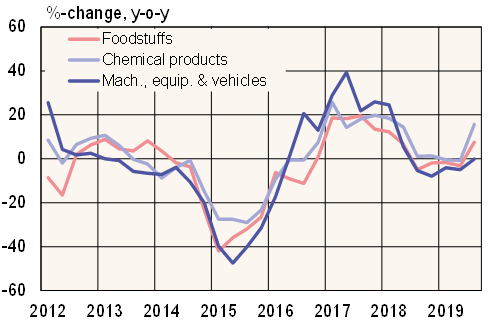BOFIT Weekly Review 46/2019
Russian foreign trade development remains muted
The value of Russian goods exports contracted by 5 % y-o-y in the first nine months of this year to a level of 390 billion dollars. The contraction mainly reflected lower oil prices. Combined export volume of crude oil and oil products grew by 1 % y-o-y. While the volume of natural gas exports through pipelines declined slightly, exports of liquefied natural gas (LNG) soared with the ramping up of production on the Yamal peninsula this year. Oil & gas still accounted for nearly two-thirds of Russia’s exports. Other important export products include metals (9% share) and chemical products (6 %). While metal exports have contracted this year, exports of chemical products have grown slightly.
The value of Russian goods imports in January-September was essentially unchanged from a year earlier, holding at around 175 billion dollars. While growth in imports of chemical products and metals was modest, imports of machinery, equipment & transport vehicles contracted slightly. Machinery, equipment & transport vehicles accounted for nearly half of imports. Other major import categories included chemical products (19 %) and foodstuffs (12 %).
The EU accounted for 45 % Russian goods exports and 36 % of goods imports. China was Russia’s largest individual trading partner, accounting for 13 % of exports and 22 % of imports. Countries in the Eurasian Economic Union accounted for just under 10 % of both exports and imports.
Change in value of Russian imports in select product categories

Sources: CEIC and BOFIT.